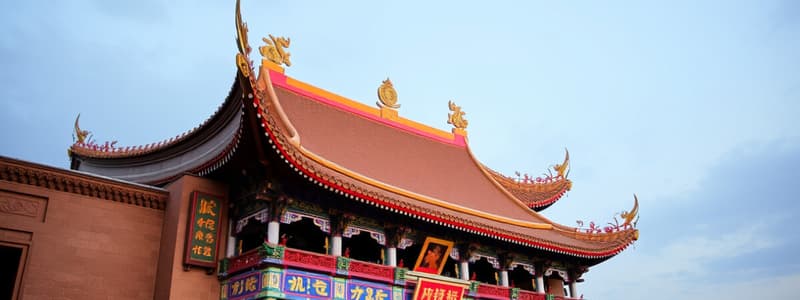Podcast
Questions and Answers
What is considered the highest form of arts in China?
What is considered the highest form of arts in China?
Chinese Theater
What is another term for Peking Opera?
What is another term for Peking Opera?
- Cantonese Opera
- Kunqu Opera
- Yueju Opera
- Beijing Opera (correct)
Peking Opera stresses precise actions rather than meaning.
Peking Opera stresses precise actions rather than meaning.
False (B)
Peking Opera is a stylized Chinese form of opera dating from the late ____ century.
Peking Opera is a stylized Chinese form of opera dating from the late ____ century.
What forms of performance are included in Peking Opera?
What forms of performance are included in Peking Opera?
Peking Opera became fully developed and recognized in the mid ____ century.
Peking Opera became fully developed and recognized in the mid ____ century.
During which dynasty was Peking Opera extremely popular?
During which dynasty was Peking Opera extremely popular?
What is the artist's goal in Peking Opera?
What is the artist's goal in Peking Opera?
The Peking opera has three main styles of music.
The Peking opera has three main styles of music.
What are the names of the two main styles of music in Peking Opera?
What are the names of the two main styles of music in Peking Opera?
What is the key difference between Erh-huang and His-p'l?
What is the key difference between Erh-huang and His-p'l?
What is fan-pan used for in Peking Opera?
What is fan-pan used for in Peking Opera?
How many musicians typically make up the Peking Opera orchestra?
How many musicians typically make up the Peking Opera orchestra?
Each performance in a Peking Opera begins with which two instruments?
Each performance in a Peking Opera begins with which two instruments?
What type of drum is sometimes used to start Peking Opera performances?
What type of drum is sometimes used to start Peking Opera performances?
Who usually creates the tempo in the Peking Opera orchestra?
Who usually creates the tempo in the Peking Opera orchestra?
The actor's delivery of lines is loosely controlled by conventions.
The actor's delivery of lines is loosely controlled by conventions.
What affects each role's vocal timbre and pitch in Peking Opera?
What affects each role's vocal timbre and pitch in Peking Opera?
Spoken passages in Peking Opera are free-form.
Spoken passages in Peking Opera are free-form.
Chanted and sung passages can be freely inserted into spoken monologues or dialogues.
Chanted and sung passages can be freely inserted into spoken monologues or dialogues.
What is a 'Ti-ts' in Peking Opera?
What is a 'Ti-ts' in Peking Opera?
What does 'Siao' refer to in Peking Opera?
What does 'Siao' refer to in Peking Opera?
What is the function of the 'Sona' in Peking Opera?
What is the function of the 'Sona' in Peking Opera?
What is the 'Hu-ch'in'?
What is the 'Hu-ch'in'?
What distinguishes 'Bu-ch'in'?
What distinguishes 'Bu-ch'in'?
What type of instrument is a 'Yue-ch'in'?
What type of instrument is a 'Yue-ch'in'?
What is a 'San-sien'?
What is a 'San-sien'?
What is the 'Pi-p'a' similar to?
What is the 'Pi-p'a' similar to?
What is a 'Tan-pi-ku' used for in Peking Opera?
What is a 'Tan-pi-ku' used for in Peking Opera?
Flashcards are hidden until you start studying
Study Notes
Chinese Theater Overview
- Chinese Theater has historically been regarded as the pinnacle of artistic expression in China.
- Peking Opera, also known as Beijing Opera, is a significant traditional form of Chinese theater.
Peking Opera Characteristics
- Emphasizes meaning over precise actions, distinguishing it from other theatrical forms.
- It traces its origins to the late 18th century, indicating a stylized Chinese opera tradition.
- By the mid-19th century, Peking Opera had reached full development and gained widespread recognition.
Cultural Significance
- Peking Opera flourished during the Qing Dynasty court, becoming a cultural treasure and widely celebrated in Chinese society.
- The performers aim to infuse exceptional beauty into every movement of their act.
Musical Elements
- Peking Opera incorporates speech, singing, mime, and acrobatics, accompanied by instrumental music.
- The music is characterized by two primary styles: Erh-huang and His-p'l, which differ primarily in sound, with His-p'l being lower in pitch.
Specific Musical Techniques
- Fan-pan is a specific musical form used for sorrowful songs performed exclusively by bearded characters.
- The orchestra typically consists of around 8 musicians positioned at the stage's corner and begins performances with ta-lo (large gong) and siao-lo (small gong).
Instrumentation
- In certain performances, a single skin drum or kettle drum may also initiate the show.
- The conductor, located at the orchestra's center, maintains tempo using the drum.
Performance Conventions
- Line delivery by actors is strictly controlled by established conventions.
- Vocal timbre and pitch are essential, as roles have specific vocal characteristics that help preserve rhythm through drawn-out syllables.
- Spoken passages adhere to strict rhythms, while chanted and sung segments are freely interspersed within dialogues.
Instruments Used in Peking Opera
- Ti-ts: a cross flute typically played along with singing.
- Siao: recorded flutes complementing vocalization.
- Sona: a trumpet announcing significant events like victories or good news.
- Hu-ch'in: a two-stringed instrument held upright against the knee.
- Bu-ch'in: another two-stringed instrument known for its graceful sound.
- Yue-ch'in: a four-stringed moon guitar contributing to the ensemble's sound.
- San-sien: a three-stringed instrument enhancing the musical aspect.
- Pi-p'a: similar to a lute with four strings, adding diversity to the music.
- Tan-pi-ku: a kettle drum that establishes the performance's tempo.
Studying That Suits You
Use AI to generate personalized quizzes and flashcards to suit your learning preferences.




